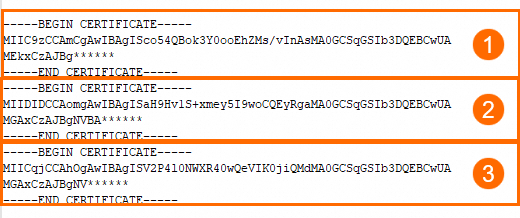This topic describes how to upload SSL certificates that use internationally accepted algorithms or the SM2 algorithm from on-premises computers to the Certificate Management Service console for centralized management. This topic also describes how to share certificates across different Alibaba Cloud accounts free of charge.
Upload a certificate
If you use a certificate that is issued from a third-party service provider, you can upload the certificate to the Certificate Management Service console for centralized management. The certificate can use an internationally accepted algorithm or the SM2 algorithm.
Before you upload a certificate, prepare the following files:
A PEM-encoded certificate file in the PEM or CRT format and a PEM-encoded private key file in the KEY format. If your certificate is in another format, you can use a tool to convert the certificate to the required format. For more information, see Convert the format of a certificate.
Note
After you upload a certificate to the Certificate Management Service console, you cannot download the certificate. This helps ensure the data security of your certificate.
Log on to the Certificate Management Service console.
In the left-side navigation pane, choose .
On the Manage Uploaded Certificates tab, click Manage Uploaded Certificates.
In the Manage Uploaded Certificates panel, configure the parameters and click OK.
The parameters that you must configure when you set Certificate Algorithm to Internationally Accepted Algorithm are different from the parameters that you must configure when you set Certificate Algorithm to SM2 Algorithm. The following tables describe the parameters.
After the certificate is uploaded, you can view the certificate in the certificate list. If you do not want to manage an uploaded certificate in the Certificate Management Service console, you can find the certificate and click Delete in the Actions column to delete the certificate.
Important
After a certificate is deleted, the certificate is removed from the list of uploaded certificates. The validity period of the certificate is not affected. A deleted certificate cannot be restored. Proceed with caution.
Share a certificate
If you have multiple Alibaba Cloud accounts and the accounts belong to the same individual or enterprise that passed real-name verification, you can share a certificate across the accounts. Then, you can deploy the shared certificate to Alibaba Cloud services free of charge.
Limits
You cannot share a certificate in the following scenarios:
You cannot share a certificate that is applied for by using an Alibaba Cloud account on the China site (aliyun.com) with an Alibaba Cloud account on the international site (alibabacloud.com). You cannot share a certificate that is applied for by using an Alibaba Cloud account on the international site (alibabacloud.com) with an Alibaba Cloud account on the China site (aliyun.com).
You cannot share a certificate that is shared to the current Alibaba Cloud account with another Alibaba Cloud account. For example, you have Alibaba Cloud accounts A, B, and C. After you use Account A to share a certificate with Account B, you cannot use Account B to share the certificate with Account C.
You cannot share an uploaded certificate.
Note
If you do not meet the conditions for sharing a certificate, you can download the certificate by using the current account and upload the certificate by using another account. For more information, see Download an SSL certificate and Upload a certificate.
Procedure
Log on to the Certificate Management Service console.
In the left-side navigation pane, choose .
On the Official Certificate tab, find the issued certificate that you want to share and click More in the Actions column.
On the Share Certificate tab, set the Account ID parameter to the ID of the Alibaba Cloud account with which you want to share the certificate. Then, click Confirm and Share.
After a certificate is shared, you can log on to the Certificate Management Service console by using the Alibaba Cloud account with which the certificate is shared and go to the Manage Uploaded Certificates tab of the SSL Certificate Management page to view the certificate. The  icon is displayed in the Status column of the shared certificate.
icon is displayed in the Status column of the shared certificate.
 Elastic Compute Service (ECS)
Elastic Compute Service (ECS)
 Container Compute Service (ACS)
Container Compute Service (ACS)

































